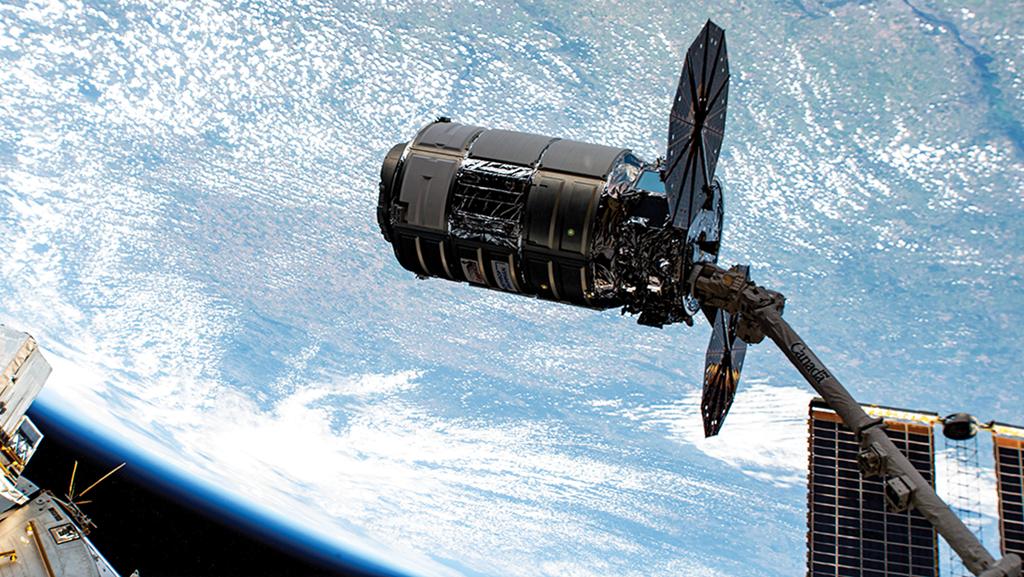
To support Voyager Space’s Starlab station, Northrop Grumman plans to develop a fully autonomous docking system for its Cygnus cargo ship, pictured being captured by the International Space Station’s robotic arm for berthing on Aug. 4.
Rather than develop and operate a commercial space station in low Earth orbit, Northrop Grumman has decided instead to expand a tried-and-true business line: flying station resupply missions onboard Cygnus cargo ships.
Northrop was one of four teams awarded NASA funding to begin developing commercial stations in low Earth orbit (LEO). The agency is looking for options to host its microgravity research experiments and technology demonstrations after the International Space Station (ISS) is decommissioned, which is targeted for 2030.
- NASA agrees to cancel station development contract
- Northrop joins Airbus on team headed by Voyager Space’s Nanoracks
But on Oct. 4, Northrop announced it was withdrawing from its 2021 Space Act Agreement—with NASA’s blessing—and joining a once-rival team headed by Voyager Space-owned Nanoracks. The Nanoracks station, known as Starlab, will be developed, built and operated in partnership with Airbus Space and Defense.
“Northrop Grumman has determined that its best strategy is to join the Nanoracks team,” Phil McAlister, NASA’s director of commercial space, said in a statement. “NASA respects and supports that decision. We continue to see a strong competitive landscape for future commercial destinations, and I am pleased that Northrop is staying with the program.”
“We are fully committed to the future of commercial LEO,” added Steve Krein, vice president for Northrop’s Civil and Commercial Space unit. “Our new role with Starlab supports NASA’s initiatives to encourage commercial space station development as part of a growing LEO economy.”
Northrop plans to develop an upgraded version of its Cygnus cargo ship, which has provided ISS resupply services since 2014. SpaceX also operates an ISS resupply line, and Sierra Space’s Dream Chaser spaceplane is expected to join the ISS fleet next year. Cygnus spacecraft, which are captured and berthed with the station’s robotic arm, so far have completed 19 resupply missions to the ISS, delivering more than 138,000 lb. of cargo.
“Under this teaming agreement, Voyager Space and Northrop Grumman agreed to a framework under which Northrop Grumman will perform services to upgrade its flight-proven Cygnus cargo vehicle with a fully autonomous docking system to support Starlab missions,” Voyager said in a statement.
Northrop plans to provide Cygnus spacecraft over an initial five-year period to support Starlab. The contract is not exclusive, leaving Northrop free to pursue cargo resupply business and services for other station operators. Northrop also is expected to provide engineering services to support Starlab’s design and development.
“This collaboration is a major step forward for the Starlab program,” Voyager Chairman and CEO Dylan Taylor said. “Northrop Grumman’s technical capability and proven success in cargo resupply services will play a pivotal role as we accelerate Starlab’s development.”
Northrop was awarded a milestone-based, $125.6 million agreement in December 2021 to develop a commercial station. The company so far has received $36.6 million. NASA said it intends to take the remaining funding from Northrop’s agreement, along with other program funding, and add paid milestones for the remaining participants in the Commercial LEO Destinations program.
In addition to Northrop, NASA agreed to fund Voyager Space’s Nanoracks, which was awarded $160 million, and Blue Origin, which won $130 million for its Orbital Reef project. The funded Space Act Agreements followed NASA’s February 2020 firm, fixed-price, indefinite-delivery, indefinite-quantity award to Axiom Space, worth up to $140 million, for development of at least one commercial module to be attached to the ISS. Axiom plans an initial four-module station that would detach to become a free flyer before the ISS is removed from orbit.
The base Starlab space station features a large inflatable habitat designed and built by Lockheed Martin, a metallic docking node, a power and propulsion element, a large robotic arm for servicing cargo and payloads and the George Washington Carver Science Park—a multipurpose laboratory for research, science and manufacturing.
With a 26-ft.-dia. module, the multilevel station is designed to launch onboard a Blue Origin New Glenn rocket or SpaceX’s upcoming Starship transport in 2028 or 2029. Starlab, which is designed to house a crew of four, is expected to reach initial operational capability with just one launch.





